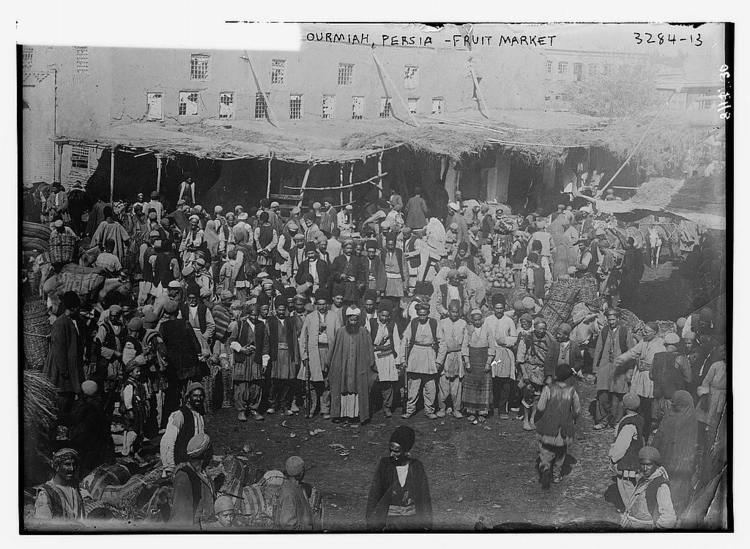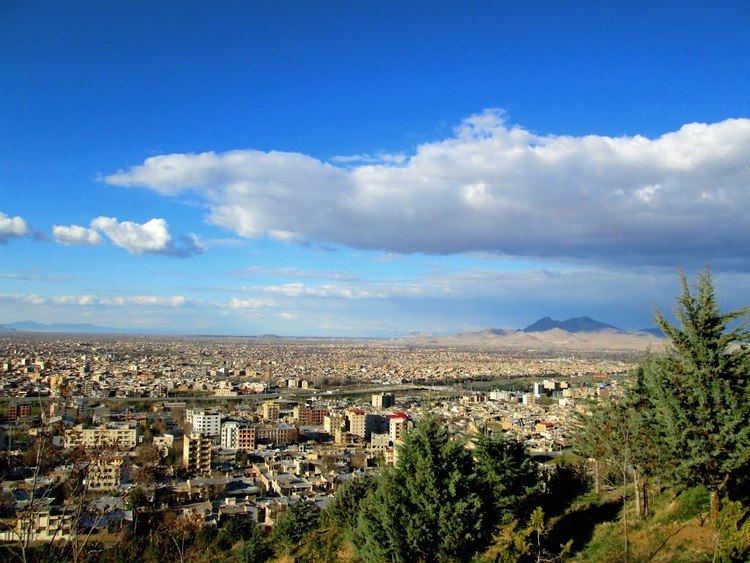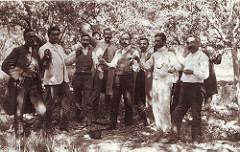Country | Mayor Hazratpoor (???? ???) | |
 | ||
Colleges and Universities Urmia University, Payame Noor University, Urmia University of Medical Sciences, Urmia University of Technology, Azad University of Urmia | ||
Map of Urmia
Urmia (Azerbaijani: ارومو –ارومیه, Persian: ارومیه ([oɾumiˈje]) is the largest city in West Azerbaijan province of Iran. Urmia is situated at an altitude of 1,330 m above sea level, and is located along the Shahar Chay river (City River) on the Urmia Plain. Lake Urmia, one of the world's largest salt lakes, lies to the east of the city and the mountainous Turkish border area lies to the west.
Contents
- Map of Urmia
- About bari and urmia tourist placeurmuurmiye
- Shrinking of the lake urmia 1963 to 2012
- Name
- History
- Demographics
- Ethnic composition
- Religions
- Parks and touristic centers
- Climate
- Sport
- Museums
- Education
- Higher education
- Libraries
- Television
- Radio
- Press
- Transportation
- Health systems
- Consulates
- People
- Twin towns and sister cities
- References

Urmia is the 10th most populated city in Iran. At the 2012 census, its population was 667,499 with 197,749 households. The city's inhabitants are predominantly Azerbaijanis, with minorities of Kurds, Armenians and Assyrians. as well as Iran's official language, Persian. The city is the trading center for a fertile agricultural region where fruits (especially apples and grapes) and tobacco are grown.

The Christian history in Urmia, Iran should be noted first. It is highly, and most intricately preserved. Especially seen in the many churches, and cathedrals.

An important town by the 9th century, Urmia was seized by the Seljuk Turks (1084), and later occupied a number of times by the Ottoman Turks. For centuries the city has had a diverse population which has at times included Muslims (Shias and Sunnis), Christians (Catholics, Protestants, Nestorians, and Orthodox), Jews, Bahá'ís and Sufis. Around 1900, Christians made up more than 40% of the city's population, however, most of the Christians fled in 1918 as a result of the Persian Campaign during World War I and the Armenian and Assyrian Genocides.

About bari and urmia tourist placeurmuurmiye
Shrinking of the lake urmia 1963 to 2012
Name
Richard Nelson Frye suggested Urartian origin for the name while T. Burrow connected the origin of the name Urmia to Indo-Iranian urmi- "wave" and urmya- "undulating, wavy", which is due to the local Assyrian folk etymology for the name which related "Mia" to Syriac meaning "water." Hence Urmia simply means 'Watertown" — a befitting name for a city situated by a lake and surrounded by rivers, would be the cradle of water.
As of 1921, Urmia was also called, Urumia and Urmi. During the Pahlavi Dynasty (1925–1979), the city was called Rezaiyeh (Persian: رضائیه) after Rezā Shāh, the dynasty's founder, whose name ultimately derives from the Islamic concept of rida via the Eighth Imam in Twelver Shia Islam, Ali al-Ridha.
History
According to Vladimir Minorsky, there were villages in the Urmia Plain as early as 2000 BC, with their civilization under the influence of the Kingdom of Van. The excavations of the ancient ruins near Urmia led to the discovery of utensils that date to the 20th century BC. In ancient times, the west bank of Urmia Lake was called Gilzan, and in the ninth century BC an independent government ruled there, which later joined the Urartu or Mana empire; in the 8th century BC, the area was a vassal of the Asuzh government until it joined the Median Empire after its formation.
During the Safavid era, the neighboring Ottoman Turks, who were the archrivals of the Safavids, made several incursions into the city and captured it on more than one occasion, but the Safavids successfully defended their control over the area. When in 1622, during the reign of Safavid king Abbas I (r. 1588–1629) Qasem Sultan Afshar was appointed governor of Mosul, he was forced to leave his office shortly afterwards due to the outbreak of a plague. He moved to the western part of Azerbaijan, and became the founder of the Afshar community of Urmia. The city was the capital of the Urmia Khanate from 1747–1865. The first monarch of Iran's Qajar dynasty, Agha Muhammad Khan, was crowned in Urmia in 1795.
Due to the presence of substantial Christian minority at the end of the 19th century, Urmia was also chosen as a site of the first American Christian mission in Iran in 1835. Another mission soon became operational in nearby Tabriz as well. During World War I the population was estimated at 30,000 by Dr. Caujole, a quarter of which (7,500) were Assyrians and 1,000 were Jews.
During the 19th century, the region became the center of a short lived Assyrian renaissance with many books and newspapers being published in Syriac. Urmia was also the seat of a Chaldean diocese.
At the beginning of the First World War tens of thousands of Assyrians and Armenians from the Ottoman Empire found refuge in Urmia. During the war, the city changed hands several times between the Russians and the Ottoman troops and their Kurdish allies the following two years. The influx of Christian refugees and their alliance with the Russians angered the Muslims who attacked the Christian quarter in February 1918, The better armed Assyrians managed however to capture the whole city following a brief battle. The region descended into chaos again after the assassination of the Assyrian patriarch Shimun XXI Benyamin at the hands of Simko Shikak one month later. Turkish armies and Simko managed to finally take and plunder the city in June/July 1918. Thousands of Assyrians were massacred as part of the Assyrian Genocide, others found refuge under British protection in Iraq,
Demographics
According to official census of 2012, the population of Urmia city is about 667,499 (with 197,749 households).
Ethnic composition
The city has been home to various ethnic groups during its history. The population of Urmia in the early Islamic period was Christian. At the beginning of the 20th century, the city had a significant Christian minority (Assyrians and Armenians) with the Christian population of the town consisting of 40-50 percent of the total population. According to Macuch, and Ishaya, the city was the spiritual capital of the Assyrians were influenced by four Christian missions which were established in the city from period from 1830 to the end of World War I. A large number of the Assyrians and Armenians were killed in 1914 during the Armenian and Assyrian genocides which resulted in a change in the city's demographics. During the era of Reza Shah Pahlavi, Iranian Assyrians were invited to return to the region and several thousand did return. There are around 5,000 Assyrians left in the city, or around 1% of the population.
Until the Iran crisis of 1946 and the Establishment of the State of Israel in 1947 several thousand Jews also lived Urmia and their language (Lishán Didán) is still spoken by an aging community in Israel.
Today the population is mostly made up of Azerbaijanis who live alongside Kurds, Assyrians and Armenians minorities.
Today the majority of the population can also speak the official language of Iran, Persian, in addition to their own native tongue.
Religions
The majority of people are followers of Shia Islam.
The city is the archiepiscopal see of the Eastern Catholic Metropolitan Chaldean Catholic Archeparchy of Urmyā, which has a suffragan in Salmas. There are also Protestants, Nestorians and Armenian Orthodox. There are four churches in the central part of the city, two being Nestorian, one Armenian and one Chaldean.
The city is also home to followers of Sunni Islam, the Bahá'í Faith, Judaism and different kinds of Yazdanism, whose adherents are Kurds.
Parks and touristic centers
Urmia has many parks and touristic coastal villages in the shore of Urmia Lake. The oldest park in Urmia, called Park-e Saat, was established in the first Pahlavi's era. Urmia's largest park is Ellar Bagi Park (Azerbaijani "People's Garden") along the Shahar Chayi, or the "City River".
Lakes and Ponds:
Lagoons:
Parks:
and ....
Touristic Coastal Villages:
Landscape Attractions:
Climate
Urmia's climate is cold semi-arid (Köppen: BSk) with cold winters, mild springs, hot dry summers and warm autumns. Precipitation is heavily concentrated in late autumn, winter (mostly in the form of snow), and especially spring, while summer precipitation is very scarce. Temperatures in Urmia are much colder than most of the remainder of Iran because of the elevation. Alhough to dry for being a traditional continental climate, it has cold enough winters to qualify for general continental.
Sport
Sport is an important part of Urmia's culture. The most popular sport in Urmia is volleyball. Urmia is considered as Iran's volleyball capital, and that is because of the ranks that Shahrdari Urmia VC got in Iranian Volleyball Super League and for the great volleyball players that play in Iran men's national volleyball team (such as Saed Marouf, Abdolreza Alizadeh, Milad Ebadipour, etc.) and first class coaches in Iran. Recently Urmia has also been called "the city of volleyball lovers" by the Fédération Internationale de Volleyball (International Volleyball Federation, FIVB) official website.
The 2010 Asian Men's Cup Volleyball Championship was held in Ghadir Arena in Urmia, 2012 WAFF Futsal Championship, and the 2012 Asian Junior Men's Volleyball Championship was also held in Urmia.
Museums
Education
The first modern style school established in urmia in 1834.
Higher education
Urmia was an important center for higher education approximately a century ago, indeed, medical faculty of Urmia which was built by Joseph Cochran and a team of American medical associates in 1878, is the first University of Iran. Unfortunately the faculty became shut down even before establishment of first official university of Iran, University of Tehran.
Nowadays Urmia has become a considerable educational city. The city owns state and private universities and institutes listed below.
Universities in Urmia:
Libraries
Television
Urmia has one state-owned television channel, West Azerbaijan TV. This channel's broadcasts are in both Azerbaijani and Farsis and it broadcasts internationally through satellite Intelsat 902.
Radio
Urmia has one radio channel broadcasting in both Azerbaijani, and Farsi. The name of the local radio is Chichest.
Press
Newsletter:
Weekly:
Beside other minor Press that are being published regularly.
Transportation
Most of Urmia's residents travel by car through the system of roads and highways. Urmia is also served by Taxis and public Buss. There are also some private groups which provide services called "Phone-taxi." A metro line for Urmia is under research.
Urmia is linked to Europe through Turkey's roads and Sero border crossing. Urmia Airport opened in 1964 and was the first international airport in West Azerbaijan county, Iran. As of April 2015 it only has regularly scheduled domestic flights to Tehran's Mehrabad International Airport. The city is not served by Iran National Railways (IRIR, Persian: رجا ).
Health systems
The Iranian government operates public hospitals in the Urmia metropolitan region. There are also a number of private hospitals and medical centers in the city. Hospitals include:
Consulates
The Turkish government has a consulate on Beheshti Ave., Urmia, Iran.
People
Within its history Urmia was the origin for many Iranian illumination and modernization movements. The city was the hometown of numerous figures including politicians, revolutionaries, artists, and military leaders. Here is a partial list of some of the people who was born or lived in Urmia.
For a complete list see: Category:People from Urmia
